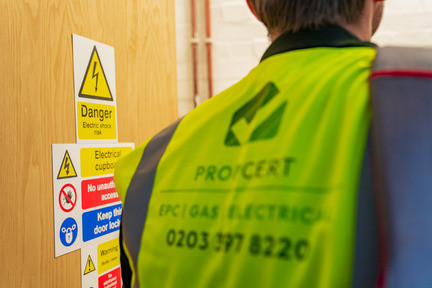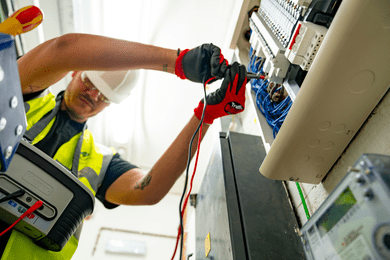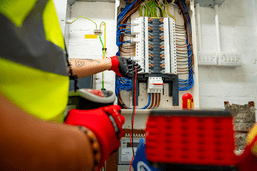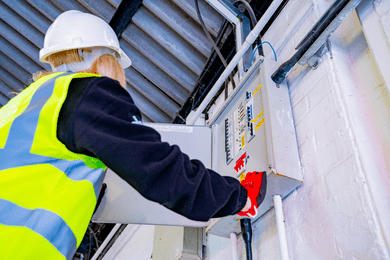EICR Test
Electrical installation must meet regulated standards in order to ensure safety. Faults with the fuse board, switches or sockets could cause electric shock or fire, causing injury and damage to occupants.
According to a report by Electric Safety First, electricity fires affect 20,000 homes in the UK every year. Electrical products cause 89 per cent of the fires, while 11 per cent are caused by faulty wiring. Most of these incidents could be avoided by regular inspection and maintenance of electric systems.
Landlords are expected to ensure the safety of every tenant throughout their tenancy in the property. This includes making sure that electrical appliances, wires and fuse boxes are safely installed and working properly.
Regular visual inspections to detect potential electrical issues are necessary. However, some cables and wires are hidden from plain sight and may be overlooked by an electrician who’s not qualified.
Have a qualified electrician check your property and issue an electrical installation condition report (EICR) to prove that your property confirms to high levels of safety standards.

Fire
20,000 fires happen in the UK every year.
Appliances
89% caused by electrical products.
Wires
11% due to faulty wirings.

WHAT IS AN EICR?
An EICR is a formal document produced by an electrician or electrical engineer after a comprehensive assessment of electrical systems within any commercial, domestic or industrial property. It is also known as the Homebuyers Test or the Landlord Safety Test.
All rental properties require an EICR based on the latest regulations of The Electrical Safety Standards in the Private Rented Sector. According to the regulations, all private landlords should make sure that all electrical installations are in good working condition.
An EICR ensures all electrical installations and systems within the property are correctly installed, safe and well maintained. It provides a vital assessment on properties of all sizes, from a small home to an industrial facility.
An EICR has five main purposes:
1. Ensure that all electrical installations on the property are safe:
A qualified engineer or electrician will inspect the electrical system to make sure that it is free of damage, wear and tear and deterioration. They also determine whether an installation or equipment is properly installed.
2. Identify damage and wear and tear that might affect the safety of occupants on a property:
Once issues are detected, the electrician will recommend corrective action to make sure that the electrical system is in good working condition.
3. Find components of an electrical installation that do not meet the Institution of Engineering and Technology’s Wiring Regulations:
Criteria includes the suitability of the control gear and switchgear, the bonding and earthing of wires and cables and the conditions of sockets.
4. Determine which electrical appliances are likely to cause shocks and fires:
An EICR determines which electrical appliances show signs of damage and wear and tear, recommending the repair and replacement of items deemed unsafe.
5. Record the condition of an electrical installation, to be used in future inspections:
The EICR also comes in handy in the event an accident occurs. It’s proof that you have taken the necessary measures to ensure the safety of your customers and employees.

WHY DOES MY PROPERTY NEED AN EICR?
Conducting a regular EICR gives you several benefits, such as:
Insurance
Several insurance companies request that you have your electrical systems tested regularly. Should you need to claim for damages from a possible electrical fault, you need to substantiate that you took the necessary steps to ensure electrical safety, including an EICR Certificate of Safety. Check your insurance policy to learn if an EICR is one of your insurer’s requirements.
Compliance with regulations
Having an updated EICR shows that you are aware of your responsibilities as a building owner or landlord as stated in laws such as:
Legal protection
An EICR is proof that you took the necessary measures to ensure the safety of everyone in the property. In case an electric fire or shock causes injury or damage to an occupant, you can use the EICR to show that you didn’t neglect your duty as a landlord or business owner, saving you costly legal and damage fees.
Safety
Regularly testing your electrical system provides peace of mind that the property is safe for you, customers and staff since there is a reduced risk of damage and injury from electrical fire and shock.
Energy efficiency
Aside from confirming that your electrical system is safe, an EICR also draws your attention to areas of improvement, reducing your energy consumption and improving your carbon footprint.
Cost-effectiveness
Reducing your energy consumption means your business saves money. Identifying electrical faults also means correcting them before they cause costly damage.
Several health and safety laws state that you are legally responsible for the safety and welfare of your tenants and employees. Failing to address the issue with your property’s electrical system puts you at risk of charges of negligence if someone in the premises is injured or suffers damage to goods due to electrocution or electric fire.
Claiming that you are unaware of electrical issues on your property does not make for a strong defence. You could be charged for non-compliance with the Electrical Safety Standards and be required to pay up to £30,000 worth of penalties.
An EICR could also determine whether your insurer will cover damages to your property caused by electrical faults. If an accident or fire occurs where electricity is suspected to be the cause and it is found in court that you were negligent on electrical safety, you’re likely to forfeit cover for damages from your insurer. You’ll have to cover the costs of repair and replacement of the property and other items, as well as legal costs should you be sued by an employee or client.


An EICR should be conducted by an experienced electrical engineer or electrician.
For commercial and rented properties, the contractor will first discuss the operational limitations with the client. The inspection might require a few minutes of downtime, or the client might have to shut down their phone lines or servers while the assessment is ongoing.
Other limitations include areas of a property that an electrician should not access, such as cables in floors and walls that might require you to cut out the plaster or flooring.
Both electrician and client must agree on a sampling rate, which determines the percentage of sockets to be tested. The two parties may agree on increasing the sample size should any faults occur during the inspection.
To perform an EICR test, the electrician will disconnect the electrical installation from the property’s main power supply. They will check the installation based on the standards set by the IET’s Wiring Regulations.
On average, an EICR inspection takes one to four hours. The length of the test depends on the size of the property, the accessibility of electrical systems and the number of electrical equipment, among other factors.
Additional inspection may be required, depending on the electrician’s findings from the comprehensive assessment.
After the inspection, the electrician will issue an EICR that you keep until the next inspection date. This is not a certificate, but simply a report that details the overall condition of your installation and the remedial work required, if needed.
The EICR will specify damages, defects, deterioration and other conditions that could put everyone in the building at risk. Pictures might be added to the report to emphasise areas of concern.
The Electrical Safety Standards require that you resolve any electrical issues within 28 days beginning with the day when you received the recommendation from the electrician.
Once the necessary corrective work is finished, the electrician will issue an EICR Certificate of Safety to verify that your electrical systems are safe.
After obtaining written confirmation from the electrician that further investigation or remedial work in the property is required, make copies and send them to each tenant within 28 days of completion of the corrective action. A copy of the report must also be sent to the local housing authority within the same time frame.
Failure to correct issues within the timeframe makes you at risk to penalties. You’ll receive a written notice from the local housing authority requesting you to address the remedial work within 21 days.
If corrective action is not completed within the given period, the local housing authority arranges for an authorised person to enter your premises to take remedial action.
The Electrical Safety Standards recommend that an EICR should be conducted at intervals of no more than five years.
A qualified electrician may recommend a more frequent inspection for the following reasons:
Age of installation:
An EICR needs to be carried out regularly for old electrical systems.
Type of property:
Properties with swimming pools need a more frequent assessment. It is recommended that these types of properties are tested every one to three years.
Environmental conditions:
A property needs to be inspected right away after fire or flooding to determine the extent of the damage of the electrical installations.
Misuse of the installation:
More frequent testing is required if the electrical system was tampered with or vandalised.
Change in usage of the property:
There could be a change of tenancy in a rental property, or a property is being prepared to be purchased or sold. Aside from ensuring that the electrical system is safe, an EICR helps determine if remedial work needs to be performed before the property changes tenancy.
Your EICR serves as proof that you complied with electrical safety standards and did the reasonable steps to ensure the safety of all occupants of your property.
You are required to give copies of EICR to the following people:
Existing tenants of the residential premises:
Copies must be given to them within 28 days after testing and inspection.
New tenants before they occupy the premises:
Prospective tenants may also request for a copy of the EICR before agreeing on a sale.
The local housing authority:
A copy must be given to them within seven days after you’ve received a written request from them.
The electrician carrying out the next EICR inspection:
This will give them a background of your electrical system before starting a new inspection.
After inspecting and testing, the electrician will apply a label to the electrical installation, indicating the date of the inspection and the recommended date for the next EICR test. The electrician must also record the next inspection date on the EICR.
The electrician may recommend a more periodic inspection based on several factors, and the recommendation must be justified in the report.
The average cost of an EICR for a two-bed flat is £120 to £150. The price can go up depending on several factors like:
Location:
Properties in the city tend to have a higher cost of EICR.
Age of the property:
Older properties require a more thorough inspection because of the deterioration and wear and tear of the electrical system.
Size of the property:
Larger properties require a more extensive inspection.
Type of property:
An industrial facility will need to be examined more thoroughly than a flat or hostel.
Extent of testing:
Although we encourage a thorough inspection of all systems, it might not be feasible given factors like your property’s layout or the nature of your business. Asking the electrician or engineer to inspect only certain areas of the property lowers the cost but may not provide a complete picture of the condition of your electrical system.
Accessibility and condition of the electrical system:
If your electrical installations are difficult to access, or if they have deteriorated over time, the contractor might charge higher.
Make sure that your EICR inspection is worth every penny with these tips:
Hire a qualified electrician or engineer:
Choose an electrician that has relevant accreditations, such as the National Inspection Council for Electrical Installation and the Electrical Contractors’ Association. These governing bodies evaluate electrical contractors to ensure they meet technical and safety standards. Ask for relevant certifications from the contractor before they show up on your property.
Read up on relevant regulations:
It might seem like a tiresome task but taking the time to read electrical safety regulations ensures that you are aware of the measures needed to make your property safe for tenants and employees. You might even find aspects from these regulations that you still have to address.
Conduct a preliminary inspection of your property:
Before an inspection by the contractor, conduct a visual inspection of your electrical system and appliances and take note of visible problems. This minimises any issues that your contractor will detect during the EICR test. A preliminary inspection also determines which areas of the electrical system you can’t reach and have to be assessed by a qualified electrician.
Remedy issues found after a visual inspection:
Once you find damaged extension cords, sockets and electrical fittings, replace them immediately. Tape extension cords, wires and cables to floors and walls when necessary. Install ground fault circuit interpreters in areas where there is a greater risk of electric shock, like bathrooms and swimming pools.
Inform your tenants beforehand:
Send a memo to your tenants that an EICR will be performed on the property. Indicate the date, how long the testing will take and what disruptions to their daily activities they can expect. This allows tenants to plan how they can continue their activities while the inspection is ongoing.
Clarify the extent of the inspection with your electrician:
Discuss with your contractor what areas of the property they can access and why some areas are limited for inspection. The agreement should be clear on the front page of the EICR, which requires the extent of the installation that has been assessed and tested. For example, it should be clear to you and the electrician that they can inspect only the common areas of a property and not the individual units.
For more information about our EICR testing and your electrical safety obligations, fill out our online form or call us on 020 3397 8220. Our team will get back to you right away.
FAQs











WHAT HAPPENS IF I DON’T PASS THE EICR?
If your EICR report reveals issues with your electrical system, the results will come out as “Unsatisfactory,” meaning there is remedial work to be done. The electrician will also provide a fixed price quotation for the remedial work. The electrician will indicate a code to specify the extent of the risk and the required action:
C1
Danger present. Risk of injury.
C2
Potentially dangerous.
C3
Improvement recommended.
FI
Further checks required without delay.
EICR TESTING BY ENERGY PERFORMANCE CERTIFICATES
An EICR should be conducted by an experienced electrical engineer or electrician.
For commercial and rented properties, the contractor will first discuss the operational limitations with the client. The inspection might require a few minutes of downtime, or the client might have to shut down their phone lines or servers while the assessment is ongoing.
Other limitations include areas of a property that an electrician should not access, such as cables in floors and walls that might require you to cut out the plaster or flooring.
Both electrician and client must agree on a sampling rate, which determines the percentage of sockets to be tested. The two parties may agree on increasing the sample size should any faults occur during the inspection.
To perform an EICR test, the electrician will disconnect the electrical installation from the property’s main power supply. They will check the installation based on the standards set by the IET’s Wiring Regulations.
UKs Largest Provider Of Property Certificates
We have inspected and tested a wide variety of residential and commercial properties all over the UK, inspecting over 5,000 properties a month. No property is too big or too small for our services.
Trusted
Our high score at TrustPilot makes us the choice contractor by over 78,000 clients. We hire local electricians who have the necessary certifications to carry out EICR inspections.
Comprehensive Testing
All our EICR inspections are conducted by a fully qualified inspector, all approved components fully tested with approved equipment, an approved certificate and a free remedial quote.
Fast Turnaround
We conduct tests in the evening, during the holidays or your preferred schedule to minimise any downtime for your business. Our electricians conduct the test in a quick yet thorough manner so you can get back to your daily activities.
Excellent Customer Service
Our EICR tests are conducted by qualified electricians and engineers who use the best equipment to assess every area of your property. They also provide professional advice on how you can maintain the safety of your electrical systems.
Low Prices
You won’t find the same quality of service at a lower price. We take pride in providing transparent pricing and we do not charge hidden or extra costs.